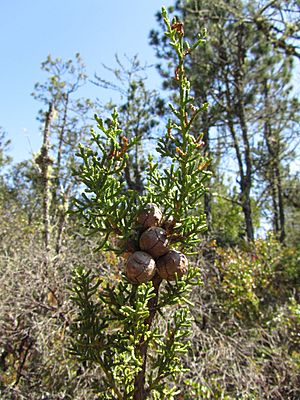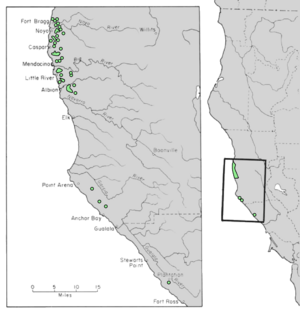Mendocino cypress facts for kids
Quick facts for kids Mendocino cypress |
|
|---|---|
 |
|
| Scientific classification | |
| Genus: |
Cupressus
|
| Species: |
pigmaea
|
 |
|
| Natural range of Cupressus pigmaea | |
The Cupressus pigmaea, also known as the Mendocino cypress or pygmy cypress, is a special type of tree. It grows only in certain coastal areas and mountains in Mendocino and Sonoma Counties in northwestern California. This tree can look very different depending on where it grows. It is closely related to another cypress tree called Cupressus goveniana. Some scientists even think it might be a type of C. goveniana.
Contents
What Does the Mendocino Cypress Look Like?
The leaves of the Mendocino cypress are a dull dark to light green. They are small and scale-like, about 1 to 1.5 millimeters long. Young cypress trees have needle-like leaves that are longer, about 8 to 10 millimeters.
The cones of this tree are small, usually 11 to 24 millimeters long. They are almost round and have six or eight scales. Inside the cones are the seeds, which are 3 to 5 millimeters long and have small wings.
How Does the Mendocino Cypress Reproduce?
The cones on the trees stay closed for many years. They only open after a forest fire kills the tree. Once the tree is dead, the cones open up. This releases the seeds, which can then grow well on the ground cleared by the fire. This is a special way for the tree to make sure its seeds have a good chance to sprout.
Differences from Other Cypress Trees
The Mendocino cypress looks a lot like C. goveniana. One main difference is that its seeds are usually shiny black, while C. goveniana seeds are dull brown. However, this isn't always true for all Mendocino cypress trees.
Scientists have also studied the genes of these trees. Some studies suggest that C. pigmaea might be related to C. macrocarpa, but most studies confirm its close link to C. goveniana. When grown side-by-side, the Mendocino cypress has a tall, thin shape and darker green leaves. In contrast, C. goveniana is usually wider and more like a bush, with lighter, yellow-green leaves.
The tallest Mendocino cypress ever recorded was found in Mendocino County. In 2000, it was 43 meters tall, with a trunk about 2.13 meters wide.
How Scientists Classify the Mendocino Cypress
Scientists don't all agree on whether Cupressus pigmaea should be its own species. Some experts, like Sargent, Wolf, and Little, believe it is a separate species. Others, like Camus, think it's a type of Cupressus goveniana. They might call it a "variety" or a "subspecies" of C. goveniana. Still others don't separate it from C. goveniana at all.
You might sometimes see the scientific name spelled pygmaea. However, this is actually a mistake in spelling. The correct spelling is pigmaea.
Where the Mendocino Cypress Lives and Grows
The Mendocino cypress can look very different depending on the soil it grows in.
Pygmy Forests
In areas with poor, acidic soil that doesn't drain well, the tree stays small. This is because the soil has a hard layer of iron called a "hardpan" that stops water and roots. In these "pygmy forests," the trees are often only 0.2 to 5 meters tall, even when they are fully grown. When it grows this way, it's often called the pygmy cypress.
Tall Forests
But if the Mendocino cypress grows in deep, well-drained soil, it can become a very large tree. It can reach heights of 30 to 50 meters and have a trunk 1 to 2.4 meters wide. The bark of these older trees is dark gray-brown, with a rough, stringy texture.
Location and Other Plants
The Mendocino cypress grows in very specific areas within Mendocino County. These areas are often coastal terraces, which are flat areas of land near the ocean. These lands were historically home to the Yuki people, a Native American tribe.
It often grows in pygmy forests alongside other trees like bishop pine (Pinus muricata) and Mendocino shore pine (P. contorta var. bolanderi). These cypress trees usually grow below 500 meters in elevation. The official soil survey for Mendocino County even mentions these pygmy cypress forests as a unique type of forest cover.
How Much Does the Pygmy Forest Produce?
Scientists have studied the pygmy forests along the Mendocino coast. These coastal terraces are about one million years old and stretch inland for five to ten kilometers from the Pacific Ocean.
In these Cupressus pygmaea pygmy forests, scientists measured how much living material (biomass) was above ground. It ranged from 1.6 to 4.4 kilograms per square meter. They also looked at how much new plant material the forest produced each year (net primary productivity). This was about 180 to 360 grams per square meter above ground. The amount of living material below ground (roots) was about 3.5 kilograms per square meter, producing 402 grams per square meter each year.
The amount of leaf area in the pygmy forest was also measured. This showed that the forest is very good at producing new growth for an evergreen plant community. Even though it's a pygmy forest, its productivity is similar to other open, dry woodlands.
See also
 In Spanish: Cupressus pygmaea para niños
In Spanish: Cupressus pygmaea para niños

